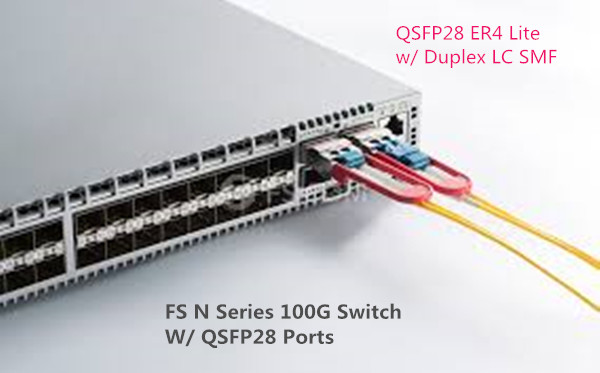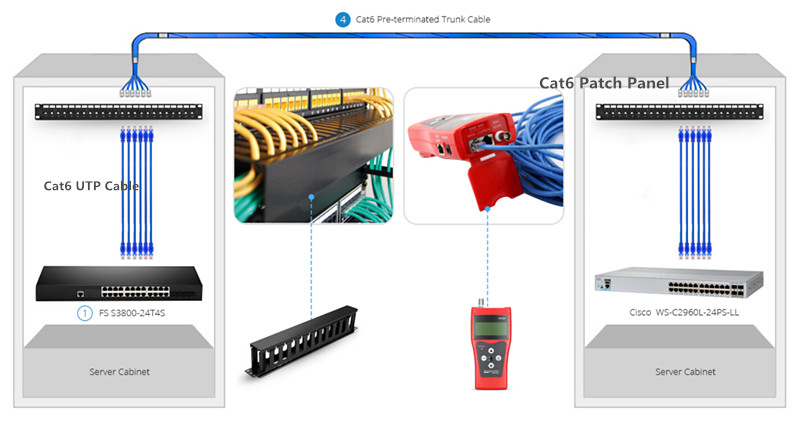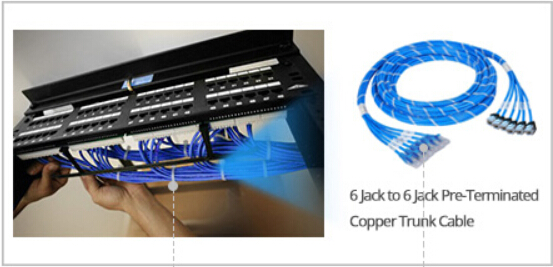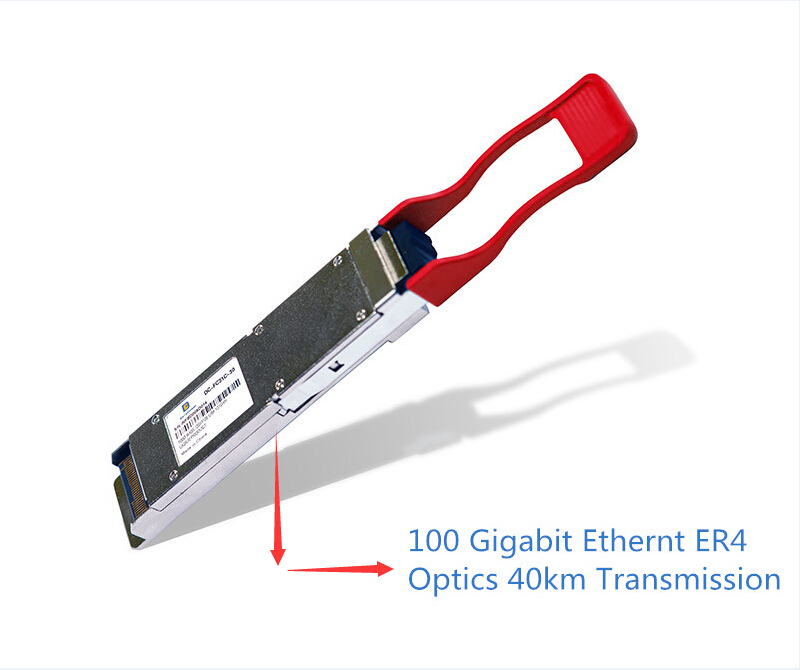October 20, 2017
Today’s world is undergoing an infrastructure transformation, which requires higher speed, greater scalability, higher performance, flexibility and reliability to meet the demands. Take 100G data rate as an example, the MSA groups keep driving development of 500m, 2km, 10km and 40km cost-effective 100G optics targeting modern data center. The 100G QSFP28 ER4-Lite standard was sampling several months ago, but now we are glad to announce that 100G QSFP28 ER4 modules are available in several vendors, e.g. FS.COM, Flexoptics, Smartoptics, etc. Today’s article will explain this long-reach 100G optics in detail.
How Does It Develop?
A heated topic—how to reach beyond 10km in 100G network aroused much attention in Reddit. For applications beyond 10km, 100GBASE-ER4 is proposed. This type of optical transceivers are manufactured by using a semiconductor amplifier (SOA) inside the transceiver to increase power budget. However, 100G ER4 is available in CFP and CFP2 form factors, but because of the large form factor and power consumption, they are seldom utilized in 100G long-reach applications. What’s worst, the newly launched 100G optical switches are commonly equipped with compact QSFP28 ports instead of larger CFP interface.
These extended reaches are preferring to use high-density 100G QSFP28 modules to maximum capacity and minimize space, power usage and maintenance cost. The CWDM4 MSA defined the first duplex low-cost 100G specification for 2km reaches based on a CWDM grid and using RS (528,514) FEC. Now the 4WDM MSA is extending the value proposition of the CWDM4 MSA and RS-FEC to define an even more cost-effective set of specifications for reaches from 10 to 40 km. Customers, particularly hyperscale cloud service providers and carriers, are looking for optimized solutions for up to 40 km.
What’s New with QSFP28 ER4-Lite Solution?
QSFP-100G-ER4L-S is designed for extended reach 100 Gigabit Ethernet link. The 100GBASE-ER4-Lite QSFP28 supports both 100GbE and OTU4 applications over single-mode fibers, and supports up to 40km with FEC and up to 30km without FEC. 100G QSFP28 ER4 Lite module consumes 4.5W power in max.

The 100 Gigabit Ethernet signal is carried over four independent channels over four LAN-WDM wavelengths—1296nm, 1300nm, 1305nm, 1309nm. Multiplexing and demultiplexing of the four wavelengths are managed within the device. This QSFP28 was standardized by ITU-T as G.959.1 4L1-9D1F and 4-Wavelength WDM MSA Group. The following table displays the existing 100G QSFP28 MSA optics in detail.
| Product | Description | Connector Type |
| QSFP-100G-SR4-S | 100GBASE SR4 QSFP Transceiver, 100m over OM4 MMF | MPO-12 (12 fibers) |
| QSFP-100G-LR4-S | 100GBASE LR4 QSFP Transceiver, 0km over SMF | LC |
| QSFP-100G-CWDM4-S | 100GBASE CWDM4 QSFP Transceiver, 2km over SMF | LC |
| QSFP-100G-PSM4-S | 100GBASE PSM4 QSFP Transceiver, 500m over SMF | MPO-12 (12 fibers) |
| QSFP-100G-ER4L-S | 100GBASE ER4 Lite QSFP Transceiver, 25-40km over SMF | LC |
The 100G QSFP ER4-Lite module will interoperate with existing ER4 solutions in the field up to 30km. Foe example, QSFP100 ER4-Lite provides backward compatibility with Cisco’s CPAK ER4-Lite, whose reach is up to 25km, and with IEEE 100GBASE-ER4 standardized transceivers, such as CFP 100G ER4, up to 30km. It also interoperates with QSFP28 and CPAK IEEE 100GBASE-LR4 modules up to 10km.
40km Transmission With FEC Turn On
To reach 40km transmission, QSFP ER4 lite requires the use of FEC on the host platform. So what is FEC? Forward Error Correction (FEC) can turn a mediocre to bad BER into a good BER. Ethernet network usually uses FEC in 1000BASE-PX (EPON), 10GBASE-KR, 10GEPON, 10GBASE-T, DSL, etc. High end long haul telecom industry also requires FEC. P802.3ba links have limited power budgets and SNR, for e.g. eye safety reasons.
Conclusion
The migration of current network infrastructure to 100G systems is inevitable, and a growing number of enterprises require 100G client interface to extend up to 40km without the use of expensive optical amplifiers. Thus, the new ER4-Lite specification enables cost-effective 100G 40km pluggable solutions in compact QSFP28 transceivers that use Forward Error Correction (FEC) and APD-based receivers. Such evolution is very exciting for not only everyone involved in its development and construction, but also for all those who seek a simple, reliable and cost-effective solution to extend the reach of their networks, without expensive network upgrades. FS.COM is devoting to change the world with our cost-effective self-developed devices, if you are interested, please feel free to contact us.
Posted by: fernxu123 at
04:29 AM
| Comments (7)
| Add Comment
Post contains 707 words, total size 7 kb.
October 12, 2017
Thanks to the complexity of the fiber optic installation and audio video system, the need for sending multiple signal types and control over long distances has increasingly become intense. Ethernet cables like Cat 5e, Cat 6 and Cat 7, is an indispensable component for home or small business. Nowadays most manufacturers will recommend the use of solid shielded Cat 6 cable with shielded connectors other than using the HDBASE-T chipset for signal extension. This type of cable can be terminated in the field or purchased in specific lengths already terminated. The following article provides a brief introduction to the reasons why we should use Pre-terminated Cat 6 cables for the signal extension.

Figure 1 shows the UTP Cat6 cables, Pre-terminated trunk cables, FS optical switches, cable manager wire duct.
Brief Outlook: Cat 6 Over Cat5 Cable
Cat5 and Cat6 copper Ethernet cables are the commonly used types for 1G/10G networks. So, what is the benefit of using Cat 6 cable instead of Cat 5?
In short, Cat 5e is a basic wire for home network. It is typically 24 gauge and can run 10 Gigabit network for 328 ft. While Cat 6 was developed to have 10 Gigabit networks. The only problem is that these wires were limited to a range of 164 feet. Above this, their speed will drop to 1Gbqs.
Besides distance and speed, Cat 6 patch cable also has another important difference, it has tighter twists in the cables. This allows each pair of wires to have two-way communication with each other. Cat 5e has an occasional delay and a higher skew than Cat 6 does. This means that even though Cat 5 can run at a speed of a Gigabit, it will appear to be slower.
Pre-terminated Solution that Saves Time, Money and Space
With connectors terminated on each end, Pre-terminated copper bundles provide a time saving and customized solution for reliable and easy to install connectivity. The Pre-terminated cables are made to your exact specifications, so there will be no unused cables left to be stored. No cable waste, faster turnaround and no terminating on site which means less money spent on storage, labor and equipment.

Figure 2 shows 6 Jack to 6 Jack Pre-terminated Copper Trunk Cable.
- Flexibility, Efficiency and Reliability
The Pre-terminated Cat 6 copper bundles can be supplied in any length up to 60m and both ends have an installed Cat 6A modular jack (UTP). The cable bundle is held together with Velcro wraps at meter intervals and is generally supplied with 6 cables & installed jacks in a bundle. Each end of the Pre-terminated can be easily installed into an unloaded 19 rack mount patch panel, floor distributor or wall outlet.
- Less labor intensive
Cat 6 Pre-terminated copper bundles require less work on site as no technical skills are needed when installing and connecting the cabling infrastructure. Therefore, this solution eliminates the need for technicians to be on site terminating cable, since the Pre-terminated cables can be easily installed by routing and then loading the Pre-terminated directly into a patch panel.
- Less Wastage
The installer in a lot of cases has to pay for his waste to be removed from site on many projects, especially if they include cable drums, more importantly the installer is purchasing a more accurate quantity of cable, they are buying by the meter and not by the drum, how many installers have their facilities cluttered up with odd lengths of cables in boxes hoping for a project that will use them up.
Pre-Terminated Cable Limitations
- Specialty cables must be planned for and ordered in advance
- Inflexible in field run situations
- Not feasible for retrofit and upgrade projects
Conclusion
Just as anything else, careful planning and product selection will be the key to a successful installation. You must consider resolution, distance, signal type or types, and physical layout when choosing a signal extension product. FS.COM Pre-terminated Cat 6 copper bundles offer rapid deployment coupled with guaranteed performance. Please feel free to contact us if you are interested.
Original Source : www.fiber-optic-solutions.com
Posted by: fernxu123 at
04:07 AM
| Comments (4)
| Add Comment
Post contains 681 words, total size 6 kb.
35 queries taking 0.0989 seconds, 90 records returned.
Powered by Minx 1.1.6c-pink.










